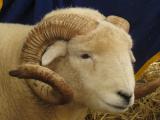
|
East Friesian Sheep(Friesian Milk Sheep, Ostfriesisches Milchschaf) The origin of the Friesian sheep breeds is the region of Friesland extending along the North Sea coast westward from the Weser River in the northeast of Germany along the north coast of the Netherlands and south to the Schelde (Scheldt) River at the border of the Netherlands and Belgium. |

|
Easy Care SheepThe guiding principle behind Easy Care is straightforward. Centuries ago, sheep didn't naturally have huge fleeces, merely a winter coat which was shed in springtime, as with most wild animals. However, man began to breed sheep for wool because of its value. In recent times, the value of wool has fallen so dramatically that its production is uneconomic. Meat production without the overhead and extra shepherding required in wool production would be much more profitable. |

|
Est à Laine Merino SheepAt the end of the 18th century, Merino blood was introduced into German sheep in the borders with France, and gradually these large "meat" Merinos were kept in large numbers in the Alsace Lorraine region of France. This strain became known as the Est à Laine, which translated means East and Wool. |

|
Exmoor Horn SheepThough ancient in origin, the Exmoor Horn, which has existed since time immemorial in the west of England, is well adapted to modern requirements. The Exmoor can be described as a dual purpose breed to keep pure on the higher moorland; in fact, they are classified as a hill breed. |